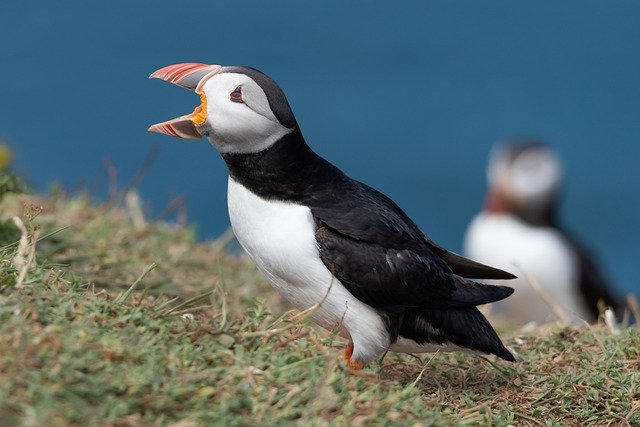Unraveling the Enigma of Puffin Courtship Rituals
Puffins, those charismatic seabirds with their distinctive colorful beaks, have long captured our imagination. But beneath their comical appearance lies a complex and fascinating world of courtship rituals that are as intriguing as they are endearing. This article delves into the lesser-known aspects of puffin mating behaviors, exploring the intricate dances, vocalizations, and social dynamics that define their romantic pursuits.

The Puffin’s Peculiar Path to Partnership
Puffins, members of the auk family, are renowned for their monogamous relationships that often span decades. Their journey to finding a mate begins with the annual return to breeding colonies, typically occurring between March and April. As these seabirds gather on rocky outcrops and grassy slopes, the air fills with a cacophony of calls and the fluttering of wings as potential mates size each other up.
Unlike many bird species where males take the lead in courtship, puffins engage in mutual displays. Both sexes participate equally in the intricate dance of attraction, a behavior that reflects their egalitarian approach to parenting. This unique dynamic sets puffins apart in the avian world and has fascinated researchers for generations.
The Bill-Knocking Ballet
One of the most iconic elements of puffin courtship is the bill-knocking display. This behavior involves two puffins facing each other and rapidly tapping their colorful beaks together, creating a distinctive sound that echoes across the colony. The intensity and duration of bill-knocking can vary, with some pairs engaging in extended sessions that last several minutes.
Researchers believe that bill-knocking serves multiple purposes. It helps puffins assess the health and fitness of potential mates, as the vibrancy of beak color and the strength of the knocking are indicators of overall condition. Additionally, this display reinforces pair bonds between established couples, serving as a form of greeting and reaffirmation of their commitment.
Vocalizations: The Language of Love
While puffins may appear silent to casual observers, they possess a rich repertoire of vocalizations that play a crucial role in courtship. These sounds range from low, growling calls to high-pitched whines, each carrying specific meanings in the context of mating rituals.
One particularly intriguing vocalization is the ‘purring’ call, a deep, resonant sound produced by both males and females during close interactions. This purr is often accompanied by a subtle swaying motion, creating an intimate moment between potential or established partners. The complexity of puffin vocalizations highlights the sophisticated nature of their social interactions and the importance of auditory cues in their mating process.
The Sky Dance: Aerial Acrobatics of Affection
Perhaps the most spectacular aspect of puffin courtship is the aerial display known as the ‘sky dance.’ This elaborate performance involves a puffin taking flight and circling above the colony, often pursued by one or more potential mates. The lead bird executes a series of rapid turns, dives, and swoops, showcasing its agility and stamina.
The sky dance serves as both a courtship ritual and a territorial display. It allows puffins to demonstrate their flying prowess, an essential skill for birds that spend much of their lives at sea. Successful completion of these aerial maneuvers can significantly enhance a puffin’s attractiveness to potential mates and help establish dominance within the colony.
Nesting Behaviors: The Final Test of Compatibility
As courtship progresses, puffin pairs begin to focus on nesting behaviors. This phase of their relationship is critical, as it tests their compatibility and ability to work together. Puffins typically nest in burrows or crevices, which they may dig themselves or inherit from previous generations.
The process of nest preparation involves both partners and can be quite labor-intensive. Puffins use their beaks and feet to excavate or clean out burrows, lining them with soft grasses and feathers. This collaborative effort not only creates a suitable environment for egg-laying but also strengthens the pair bond through shared labor and decision-making.
Conservation Implications of Puffin Courtship
Understanding puffin courtship rituals is not merely an academic pursuit; it has significant implications for conservation efforts. As climate change and human activities continue to impact seabird habitats, preserving the conditions necessary for successful breeding becomes increasingly critical.
The complex nature of puffin mating behaviors underscores the importance of protecting entire ecosystems rather than focusing solely on individual species. Factors such as food availability, predator dynamics, and habitat stability all play crucial roles in supporting healthy puffin populations and enabling their intricate courtship rituals to unfold naturally.
In conclusion, the courtship rituals of puffins offer a window into the remarkable adaptations and social complexities of these beloved seabirds. From bill-knocking displays to aerial acrobatics, every aspect of their mating process reflects millions of years of evolution and fine-tuning. As we continue to study and appreciate these behaviors, we gain not only a deeper understanding of puffin biology but also valuable insights into the delicate balance of marine ecosystems and the urgent need for their conservation.





